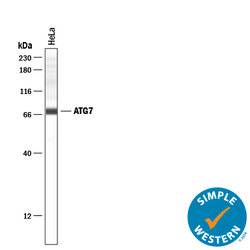Antibody data
- Antibody Data
- Antigen structure
- References [4]
- Comments [0]
- Validations
- Western blot [2]
- Immunohistochemistry [1]
- Flow cytometry [1]
Submit
Validation data
Reference
Comment
Report error
- Product number
- MAB6608 - Provider product page

- Provider
- Novus Biologicals
- Product name
- Mouse Monoclonal ATG7 Antibody
- Antibody type
- Monoclonal
- Description
- Protein A or G purified from hybridoma culture supernatant. Detects human ATG7 in direct ELISAs and Western blots. In direct ELISAs and Western blots, no cross-reactivity with recombinant human ATG3, 4A, 4B, 5, 10, 12, or 16L1 is observed.
- Reactivity
- Human, Mouse
- Host
- Mouse
- Conjugate
- Unconjugated
- Isotype
- IgG
- Vial size
- 100 ug
- Concentration
- LYOPH
- Storage
- Use a manual defrost freezer and avoid repeated freeze-thaw cycles. 12 months from date of receipt, -20 to -70 degreesC as supplied. 1 month, 2 to 8 degreesC under sterile conditions after reconstitution. 6 months, -20 to -70 degreesC under sterile conditions after reconstitution.
Submitted references Autophagy drives fibroblast senescence through MTORC2 regulation.
Histone deacetylase 3 is required for iNKT cell development.
Altered mitochondrial quality control signaling in muscle of old gastric cancer patients with cachexia.
Autophagy fosters myofibroblast differentiation through MTORC2 activation and downstream upregulation of CTGF.
Bernard M, Yang B, Migneault F, Turgeon J, Dieudé M, Olivier MA, Cardin GB, El-Diwany M, Underwood K, Rodier F, Hébert MJ
Autophagy 2020 Nov;16(11):2004-2016
Autophagy 2020 Nov;16(11):2004-2016
Histone deacetylase 3 is required for iNKT cell development.
Thapa P, Romero Arocha S, Chung JY, Sant'Angelo DB, Shapiro VS
Scientific reports 2017 Jul 19;7(1):5784
Scientific reports 2017 Jul 19;7(1):5784
Altered mitochondrial quality control signaling in muscle of old gastric cancer patients with cachexia.
Marzetti E, Lorenzi M, Landi F, Picca A, Rosa F, Tanganelli F, Galli M, Doglietto GB, Pacelli F, Cesari M, Bernabei R, Calvani R, Bossola M
Experimental gerontology 2017 Jan;87(Pt A):92-99
Experimental gerontology 2017 Jan;87(Pt A):92-99
Autophagy fosters myofibroblast differentiation through MTORC2 activation and downstream upregulation of CTGF.
Bernard M, Dieudé M, Yang B, Hamelin K, Underwood K, Hébert MJ
Autophagy 2014;10(12):2193-207
Autophagy 2014;10(12):2193-207
No comments: Submit comment
Supportive validation
- Submitted by
- Novus Biologicals (provider)
- Main image

- Experimental details
- Detection of Human ATG7 by Western Blot. Western blot shows lysates of HeLa human cervical epithelial carcinoma cell line and HepG2 human hepatocellular carcinoma cell line. PVDF membrane was probed with 2 µg/mL of Mouse Anti-Human ATG7 Monoclonal Antibody (Catalog # MAB6608) followed by HRP-conjugated Anti-Mouse IgG Secondary Antibody (Catalog # HAF007). A specific band was detected for ATG7 at approximately 75 kDa (as indicated). This experiment was conducted under reducing conditions and using Immunoblot Buffer Group 1.
- Submitted by
- Novus Biologicals (provider)
- Main image

- Experimental details
- Detection of Human ATG7 by Simple WesternTM. Detection of Human ATG7 by Simple WesternTM.
Supportive validation
- Submitted by
- Novus Biologicals (provider)
- Main image

- Experimental details
- ATG7 in Human Brain. ATG7 in Human Brain.
Supportive validation
- Submitted by
- Novus Biologicals (provider)
- Main image

- Experimental details
- Detection of ATG7 in HeLa Human Cell Line by Flow Cytometry. HeLa human cervical epithelial carcinoma cell line was stained with Mouse Anti-Human/Mouse ATG7 Monoclonal Antibody (Catalog # MAB6608, filled histogram) or isotype control antibody (Catalog # MAB002, open histogram), followed by Allophycocyanin-conjugated Anti-Mouse IgG Secondary Antibody (Catalog # F0101B). To facilitate intracellular staining, cells were fixed with Flow Cytometry Fixation Buffer (Catalog # FC004) and permeabilized with Flow Cytometry Permeabilization/Wash Buffer I (Catalog # FC005). View our protocol for Staining Intracellular Molecules.
 Explore
Explore Validate
Validate Learn
Learn Western blot
Western blot Immunocytochemistry
Immunocytochemistry